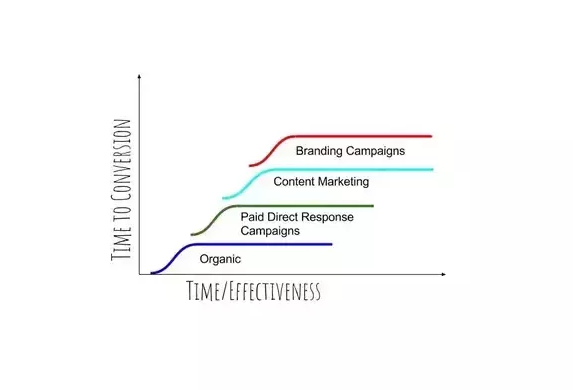
What is the best way to start getting better at copywriting and building your brand identity online? originally appeared on Quora - the place to gain and share knowledge, empowering people to learn from others and better understand the world.
Answer by Jessica Taylor, Marketing Executive, Keepsafe Software, on Quora:
While marketers often focus on bottom-of-the-funnel conversion; you must also feed your marketing funnel. You accomplish this by raising brand awareness and generating interest with potential customers. The best way to do that is with a brand narrative.
Brand narrative
A brand narrative is the defining story and imagery that connects your customers to your brand. A brand narrative envelops your company’s mission, your company’s core values, your founders’ vision, your brand attributes and your users’ voices. A brand narrative captures your brand’s essence and describes its value.
Backstory
I joined Keepsafe a year ago. At the time, Keepsafe had a flagship app, Photo Vault on iOS and Android, with 50 million installs and a mission to help people control their digital privacy. Though the business fundamentals and vision were stellar, Keepsafe hadn’t received notable press in four years.
After going through the exercise below, I landed nine major media headlines in my first six months. Since press draws attention to a company’s story and attracts new customers; that’s how I knew what I was doing was working... We’ve since grown to more than 65 million installs and landed a total of 26 press headlines. While headlines can’t measure customer connection, they are a leading indicator of public relevance and interest, and a source for growth.
Startup marketing
As a former founder, I approached startup marketing with an entrepreneurial lens. I followed Tomasz Tunguz’s blog and adapted a diagram he popularized to evaluate our product lifecycle and put together Keepsafe’s marketing program.

In my experience, when you’re getting a startup off the ground, the most important thing is achieving product-market fit. If you have it, you’ll generate enough organic interest that you hardly need marketing at all. Even with product market fit, over time, organic growth is bound to plateau, which is a great time to start a paid marketing program. Eventually paid marketing also levels off, when you are no longer able to acquire customers and stay revenue-positive beyond a scalable cost-per-acquisition. This is when you see many businesses start to invest in content and brand marketing to generate interest in their offerings.
Category design
Soon after starting at Keepsafe, our CEO, Zouhair Belkoura, introduced me to a branding framework and book called Play Bigger. The authors posit that market leaders “play big” by positioning themselves and creating their own product categories. Category leaders define a consumer problem, name the solution, tell the world and ultimately win market share. Companies whose solutions have become synonymous with their categories include Google (search) and Facebook (social network). Play Bigger’s authors also relate stories about companies that created their own categories. For example, when Chrysler introduced its Dodge Caravan and Plymouth Voyager in 1984, the category “minivan” was born. (Now most people with families can’t avoid a minivan even if they want to—myself included!)
For Keepsafe, the privacy and security category wasn’t working. It was muddled and meant lots of things to lots of people, but it didn’t communicate Keepsafe’s value to customers and drive enough interest. This was an opportunity for me to redefine our company’s category, position Keepsafe and explain why our brand should matter to people.
Past, present and future
Keepsafe had gone through a rebrand before I joined; and I was lucky enough to inherit an excellent set of brand guidelines. I began developing our brand category and narrative by revisiting our brand attributes, values and voice. Our brand identity communicated how fundamental personal privacy was to human existence.
But our company vision had since evolved. We were setting out to create a family of apps that would make privacy and security simple for ordinary people. With Keepsafe Photo Vault, an app for keeping pictures on your phone private, we were protecting what people had. With our October launch of a virtual private network mobile app, Keepsafe VPN, we could now also protect where people went. In the future, we planned to develop apps that could also protect what people said and who they were — like private messaging and identity theft protection services.
Our new brand category had to reflect where we’d been as well as where we planned to go.
Origin story
My next stop was interviewing our founders to understand how and why they came to develop Keepsafe. Both of Keepsafe’s founders hail from Germany. When our CEO, Zouhair Belkoura, came to the U.S., he was working as a Product Manager inside a conservative company culture. Because Zouhair was German, he often went out on the weekends with his friend, Philipp Berner, now Keepsafe’s CTO. Zouhair would often reference whiteboard pictures on his phone with colleagues. He was embarrassed when he’d have to swipe through pictures of silly faces with Philipp over beers to get to the relevant whiteboard photos. And he figured he must not be the only person to experience this problem...
Zouhair explained that privacy was all about context. Whereas he might feel perfectly comfortable showing family and friends pictures of beer drinking; he didn’t feel the same way about having his coworkers see them.
Customers, customers, customers
There’s no substitute for talking to the people who use your product about why they use it. Our UX designer and I have conducted countless interviews with Keepsafe users to better understand how they use our product and feel about our brand. We also regularly survey customers to gain deeper insights into why they use our products and how they help them.
What people tell us time and time again is that they aren’t as worried about protecting their privacy from surveillance and hackers (though they do worry about that), but rather from people in their lives who invade their privacy. They’ve told us about the stress it puts on their relationships and how and why they trust Keepsafe.
These are the human stories behind the data that are so critical to contextualizing how you talk to customers and build a relationship with them for the long-term. Pay close attention to what your customers say about their connection with your brand — it’s critical to include in your brand narrative because it’s the emotional and social proof that will win others’ loyalty.
Data-driven insights
Because Keepsafe is all about protecting people’s privacy, we have strict standardsfor customer security, and we respect people’s boundaries in user interviews. But I wanted to know more about who our users were and why they used Keepsafe. I developed a short demographic survey to learn more about our users’ gender, age, location, relationship status, education, income-level and primary use case. We showed the survey in-product and received more than 6,000 responses. It turns out that people’s responses are occasionally more candid in a survey than in a telephone interview.
These newfound insights were critical to understanding who our users are and how to talk to them. They also reaffirmed that Keepsafe had latched onto a killer use case.
Brand value
After taking in all of these inputs, I spent a couple of weeks exploring new ideas and processing the information. I considered the space that Keepsafe carved out for people where they could be themselves, free from judgement.
I read about proxemics, the study of interpersonal distance. When we talk about our physical space, we often refer to the distance that people feel comfortable with as “personal space.” But didn’t personal space apply to our digital worlds as much as it applied to our physical world? I had arrived at Keepsafe’s brand category: personal space protection.
Brand story
Sitting down to write the brand narratives was my favorite step in the process. Now that all of the research and analysis was behind me, I could finally get creative! As the authors of Play Bigger suggested, I wrote the movie trailers for our brand. I channeled our users, our founders and our brand elements. I tried to capture the emotional appeal behind our product line. The individual stories came fast. In total, I wrote three narratives (1, 2, 3) and presented them to my leadership team in presentations with a few words on each screen. Then I used their feedback to refine, tighten and edit each narrative down to its most basic form of expression.
Narrative tests and interpretation
Everyone in your company is bound to have a favorite narrative, but no one is the expert on reaching your target market except your target market. This is why you must test! I worked with our designer to create simple text videos. With the help of Open Oceans, my extended digital marketing team, we ran these videos on YouTube and Facebook with a limited budget to maximize engagement and reach. There was one problem: two of the three narratives tied for click-throughs and impressions. That’s when I dug into the audience insights and paired them with our company and product strategy. One narrative was more popular with Keepsafe’s current target demographic. It was a great representation of where our product line and company were today. The second narrative appealed to a broader demographic with a higher lifetime value, a group far more representative of where we were going and who we wanted Keepsafe’s future customer to be. The answer was simple.
Storytelling and realization
I worked with a talented videography team to make a simple video that brought visual interest and life to our narrative.
Then, editorially, I began weaving “personal space protection” into every pitch I sent journalists and every press release and blog post I wrote. I also started getting ahead of relevant privacy stories; interpreting them for Keepsafe and putting the personal space protection spin on them. I learned that I could simultaneously engage Keepsafe’s audience while further developing our narrative with our owned channels like Keepsafe’s blog, Twitter feed and Facebook page. I started noticing patterns in our response rates and blog stats about what stories certain journalists preferred and what topics were of the most interest to Keepsafe’s readers. When something worked, I kept doing it!
Brand building
I’ve managed to get Keepsafe mentioned or featured in media outlets 26 times, grew our readership six times, and increased Keepsafe’s installs since I set out on this brand narrative odyssey. Here’s what I’ve learned:
- Follow the playbook (above); there’s no substitute for doing the research and groundwork.
- When a hard earned growth tactic pays off, rinse and repeat.
- Keep going back to bat.
Every week, I brainstorm new ideas to get the word out about Keepsafe. I listen to podcasts, follow the journalists that are writing groundbreaking pieces on privacy and security, and pepper my founders with questions about how they interpret what’s happening in the space. Then I go out and do it all again so that our brand evolves along with our story.
This question originally appeared on Quora - the place to gain and share knowledge, empowering people to learn from others and better understand the world. You can follow Quora on Twitter, Facebook, and Google+. More questions:
